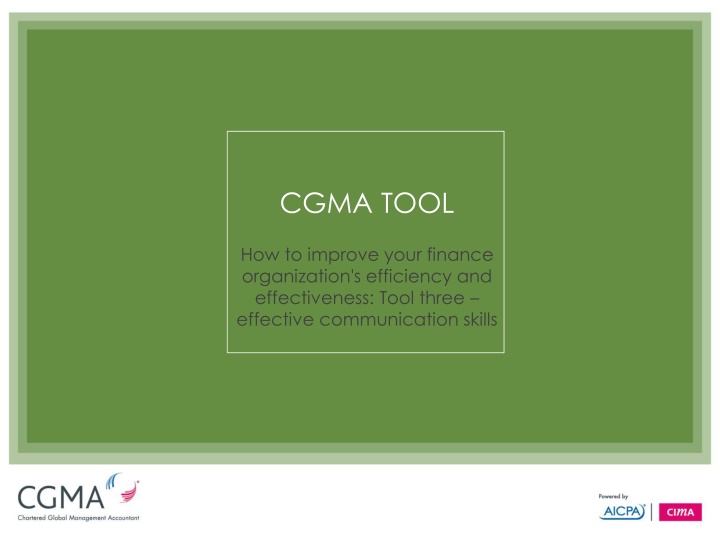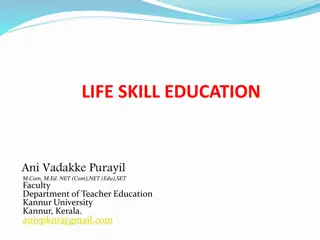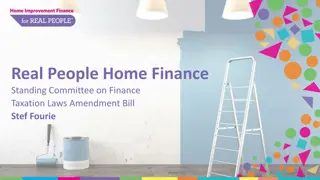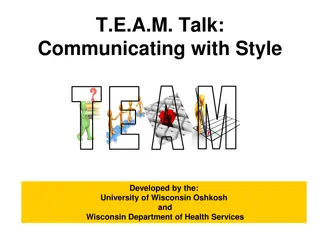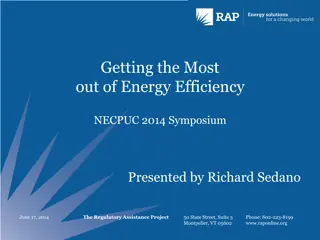Enhancing Finance Organization Efficiency through Effective Communication Skills
Management accountants face increasing pressure to communicate effectively in order to meet stakeholder demands for accurate and transparent information. Global CEOs recognize communication as a critical skill for financial staff success. To improve communication, understanding different types of communication, body language, barriers, and key skills like listening and feedback is essential. This aids in leveraging management accounting skills across functions to achieve organizational goals.
Download Presentation

Please find below an Image/Link to download the presentation.
The content on the website is provided AS IS for your information and personal use only. It may not be sold, licensed, or shared on other websites without obtaining consent from the author.If you encounter any issues during the download, it is possible that the publisher has removed the file from their server.
You are allowed to download the files provided on this website for personal or commercial use, subject to the condition that they are used lawfully. All files are the property of their respective owners.
The content on the website is provided AS IS for your information and personal use only. It may not be sold, licensed, or shared on other websites without obtaining consent from the author.
E N D
Presentation Transcript
CGMA TOOL How to improve your finance organization's efficiency and effectiveness: Tool three effective communication skills
Paul Stahlin, CPA, CGMA Regional President, Fulton Bank of New Jersey
Senior management ranks communication as a skill in most need of improvement by finance personnel RANK SKILL TO IMPROVE 1 Interpersonal 2 COMMUNICATION 3 Strategic 4 Technical 5 Leadership Ranking from CGMA report, From ledgers to leadership: A journey through the finance function
According to the CGMA report, The Fast-Track to Leadership, management accountants are increasingly pressured to become effective world-class communicators. Management accountants are challenged by the need to communicate complicated issues to different audiences financial analysts, customers, partners and employees as stakeholders require correct information and transparency in real time. Efficient communication is essential.
Effective communication is required to leverage the management accounting skill set across different functions to fulfil organisational objectives. Global CEOs agree that communication is a top personal attribute that is critical for the success of financial staff. From the CGMA report, The Fast-Track to Leadership: The challenges, opportunities and action plan.
How can management accountants know they are being effective communicators? By understanding: Types of Communication Body Language Types of Communication Flow Barriers to Communication Key Communication Skills Listening Feedback and Feedforward Presentation Note: these are general tips, therefore, you need to take into consideration who you are communicating with, especially in different cultures.
Types of Communication
Types of Communication Verbal Non-Verbal Verbal Occurs through the act of speaking, or through writing, such as emails. Non-Verbal Usage of signals, such as facial expressions, body language, gestures and eye contact.
When interacting with others, body language sends strong messages. Body language tells others if you are interested, honest or even listening. When body language is in line with the words being spoken, it increases trust, clarity and rapport. When it does not match, it may create confusion, doubt and anxiety. Body language matters.
Tips to improve body language Look but don t stare Maintaining too much eye contact may make others uncomfortable, but too little eye contact may make you seem less confident or untrustworthy. Stand up straight Don t slouch. Good posture helps to communicate confidence. Don t cross or fold Folding arms and crossing legs may be perceived as a defensive or guarded gesture. Smile often Smile when communicating with others. It makes you seem friendly and approachable. People will be more likely to listen to someone in a positive mood.
Tips to improve body language (continued) Lean forward Leaning toward a speaking person indicates your interest in what is being said. Don't fidget Fidgeting is distracting and may make you seem nervous or anxious. Mirror Improve your connection in the conversation by periodically mirroring the other person s body language.
Types of Communication Flow
Types of Communication Flow Upward Communication that begins from the bottom of an organisation and flows to the top. Downward Communication that begins at the top of an organisation and flows down. Lateral Communication between colleagues or laterally equal members of an organisation. Multi-directional The use of horizontal, upward and downward communication flows. Upward to Supervisor Laterally to Coworkers or Another Department COMMUNICATION FLOW Downward to Subordinates
Barriers to Communication
Barriers to Communication Barriers to communication include anything that prevents people from communicating as effectively as possible. A few key barriers are: LANGUAGE CULTURAL GENDER
LANGUAGE The use of internal or technical jargon is often a hidden language barriers that we aren t always aware exists. CULTURAL Different cultures, whether they be race, ethnicity, religious or the work culture of a company, can interfere with communication if different for cultures, therefore, needs to be taken into consideration. GENDER Although both sexes have both kinds of communicators, women tend to be right-brain communicators: abstract and intuitive. While men are more likely left-brain communicators: linear and logical. Both sexes have to learn how to communicate in a way that allows persons of the opposite sex to receive and understand information.
Key Communication Skills Listening Skills Feedback and Feedforward Skills Presentation Skills
Hearing vs. Listening According to the Merriam- Webster Dictionary, the definition of hearing is the process, function, or power of perceiving sound whereas listening is to consider with thoughtful attention. Hearing is a physical attribute, but listening is a cognitive reaction to what you hear.
Most Common Barriers to Listening Barriers to Hearing Barriers to Listening Background noise Health issues Lack of interest Fatigue Distractions Environment Impatience Results of poor listening Miscommunication Loss of opportunities Wasted time
23 23 23
Listening Self-Assessment Read each item and indicate how frequently you use this skill when talking to others: Usually Do Do Should Do More Often Sometimes Make others feel at ease when I am talking to them. Do not think about other things when listening to others. Separate my own ideas and thoughts from the speaker s. Listen to others with whom I disagree. Do not form a rebuttal in my head while others are talking. Observe others verbal and nonverbal behaviors.
Effective Listener Characteristics Practice active listening Evaluate speaker s words and feelings Empathise with speaker Give feedback Tip: To become a better listener, practice active listening.
Key Elements of Active Listening Pay attention Indicate Give feedback Delay judgment Summarise sometimes Respond appropriately Tip: If it is difficult to concentrate on what someone is saying, try repeating their words to yourself as they say them.
Pay Attention Give the speaker your full attention and acknowledge what you ve heard. Look at the speaker. Do not mentally prepare a counter argument. Avoid being distracted by surroundings. Avoid side conversations in a group setting.
Indicate Use your body language to indicate your attention. Nod occasionally. Smile and use other positive facial expressions. Use good posture to denote confidence and openness.
Provide Feedback Our personal feelings, assumptions, judgments and beliefs can skew what we hear. Reflect back by paraphrasing. - What I'm hearing is ... - Sounds like you are saying Clarify points by asking questions. - When you said what did you mean? - Is this what you mean? Reflect, clarify and summarise the speaker s comments often.
Defer Judgment Interrupting is rude and wastes time. Allow the speaker to finish before speaking. Avoid interrupting with counter arguments.
Respond Appropriately Be open and honest when responding. Respectfully speak your opinions. Treat the other person the way you would want to be treated.
Four Types of Feedback Negative feedback corrective comments about past behavior (Things that didn t go well) Positive feedback validating comments about past behavior (Things that went well and need to be done again) Negative feedforward corrective comments about future behavior (Things that should not be repeated next time) Positive feedforward validating comments about future behavior (Things that may improve future performance)
Effectively using the four feedback types Make sure you use them all. Understand the importance of each type and share input for each type. First, ask the other person their opinion. Ask questions without being interrogatory. - Feedback Examples: What did you think went well? What do you wish you had done differently? - Feedforward Examples: Knowing what you now know, what would you do different? What challenges will you avoid next time? What will you ensure you do next time?
Connect all feedback together. Establish the relationship between past performance and how it relates to the future. Tying together past and future can help prevent defensive behavior. More and, less but. When you tie ideas together, use the word and not but. - But cancels out everything said prior to the word - And seems positive and inclusive Future Focused. Although feedback should be balanced, the primary focus should be on the future. Always end the conversation discussing the future because you cannot change the past.
Presentation Skills A presentation is a way of communicating information, influencing, persuading or motivating a group of people.
4 Elements of a Great Presentation Content Ensure you have the right presentation for your audience. Keep the content simple and focused but make sure to exceed the audience s expectations. Structure Make sure your presentation is well-organised with a logical beginning, middle and end. Ensure it is structured and paced so that the audience can follow it. Rehearse If a presentation is not presented well, it will not be effective. Make sure you rehearse in order to ensure success. Human Element Engage the audience. Involve the viewers by making them interested in the presentation through use of a visually appealing colour scheme, a personal story or anecdote, visual effects, etc.
Presentation Structure There are several options for structuring the presentation: Timeline: Order is sequential. Climax: Order main points based on increasing importance. Problem/Solution: A problem is given, a solution is suggested and benefits are then presented. Classification: The major points are the important items. Simple to complex: Ideas are presented from the simplest to the most complex.
Presentation Skills Preparation: audience analysis What is the audience interested in? What does the audience know and need to know? What does the audience want, need and expect? How will the audience benefit? Structure the content in line with the audience s needs What do you want to communicate to the audience? What is your objective? Prepare presentation for the time allotted. Anticipate the questions and prepare answers. Attain material from a myriad of sources. Arrange key points in logical or sequential order. Prepare handouts, if needed. Allow sufficient time for Q&As.
Presentation Tips and Techniques Do not read directly from handouts. The audience will not know if they should read along or listen. Do not put both hands in your pockets; it may make you appear unprofessional. Face the audience and speak directly to them. Do not lean on the podium. Speak up and speak clearly. Refrain from using a monotone voice. Also, use inflection to stress important points. Walking around the room will create physical closeness to the audience. Do not wave a pointer or pencil around in the air. The audience will begin to watch the item in your hand instead of listening to you.
References and further reading The fast-track to leadership: The challenges, opportunities and action plan, http://www.cgma.org/Resources/Reports/Pages/fast-track-to-leadership.aspx From ledgers to leadership a journey through the finance function 2012 update, http://www.cgma.org/Resources/Reports/Pages/ledgers-to-leadership.aspx Six tips for finance professionals wanting to move up the career ladder, http://www.cgma.org/resources/tools/pages/six-tips-for-career-progression.aspx The competencies required of finance professionals, http://www.cgma.org/Resources/Reports/ DownloadableDocuments/ledger-ch2-competenciesrequired.pdf Survey highlights most common mistakes managers make with employees, http://www.cgma.org/Magazine/News/Pages/20125615.aspx Key communication skills for accountants Robert Half International, http://roberthalfmr.cb- mobile.com/RHMR/Article.html?categoryId=6,1 Better listening, http://www.toastmasters.org.nz/speaking_resources/better_listening.html Dale Carnegie leadership training, http://www.dalecarnegie.com/ The Art of Public Speaking by Stephen Lucas (Oct 4, 2011), http://www.amazon.com/The-Public- Speaking-Stephen-Lucas/dp/0073406732/ref=sr_1_6?s=books&ie=UTF8&qid=1341328416&sr=1-6 Effective communication skills, mhttp://www.e-booksdirectory.com/details.php?ebook=5236 Listening skills, http://www.karenfriedman.com/ IWCC training in communications, http://www.iwcctraining.com/ Communications: Methods and Applications for Financial Managers (available on CGMA.org in November 2012)
American Institute of CPAs 1211 Avenue of the Americas New York, NY 10036-8775 T. +1 212 596 6200 F. +1 212 596 6213 Chartered Institute of Management Accountants 26 Chapter Street London SW1P 4NP United Kingdom T. +44 (0)20 7663 5441 F. +44 (0)20 7663 5442 www.cgma.org August 2012
